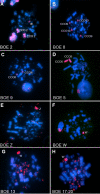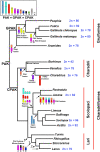Chromosomal painting in Charadrius collaris Vieillot, 1818 and Vanellus chilensis Molina, 1782 and an analysis of chromosomal signatures in Charadriiformes
- PMID: 35947613
- PMCID: PMC9365183
- DOI: 10.1371/journal.pone.0272836
Chromosomal painting in Charadrius collaris Vieillot, 1818 and Vanellus chilensis Molina, 1782 and an analysis of chromosomal signatures in Charadriiformes
Abstract
Charadriiformes represent one of the largest orders of birds; members of this order are diverse in morphology, behavior and reproduction, making them an excellent model for studying evolution. It is accepted that the avian putative ancestral karyotype, with 2n = 80, remains conserved for about 100 million years. So far, only a few species of Charadriiformes have been studied using molecular cytogenetics. Here, we performed chromosome painting on metphase chromosomes of two species of Charadriidae, Charadrius collaris and Vanellus chilensis, with whole chromosome paint probes from Burhinus oedicnemus. Charadrius collaris has a diploid number of 76, with both sex chromosomes being submetacentric. In V. chilensi a diploid number of 78 was identified, and the Z chromosome is submetacentric. Chromosome painting suggests that chromosome conservation is a characteristic common to the family Charadriidae. The results allowed a comparative analysis between the three suborders of Charadriiformes and the order Gruiformes using chromosome rearrangements to understand phylogenetic relationships between species and karyotypic evolution. However, the comparative analysis between the Charadriiformes suborders so far has not revealed any shared rearrangements, indicating that each suborder follows an independent evolutionary path, as previously proposed. Likewise, although the orders Charadriiformes and Gruiformes are placed on sister branches, they do not share any signature chromosomal rearrangements.
Conflict of interest statement
The authors have declared that no competing interests exist.
Figures







Similar articles
-
A conserved karyotype? Chromosomal rearrangements in Charadrius collaris detected by BAC-FISH.PLoS One. 2023 Jan 11;18(1):e0280164. doi: 10.1371/journal.pone.0280164. eCollection 2023. PLoS One. 2023. PMID: 36630423 Free PMC article.
-
Chromosome Painting in Vanellus chilensis: Detection of a Fusion Common to Clade Charadrii (Charadriiformes).Cytogenet Genome Res. 2015;146(1):58-63. doi: 10.1159/000431387. Epub 2015 Jun 16. Cytogenet Genome Res. 2015. PMID: 26088018
-
Chromosomal painting of the sandpiper (Actitis macularius) detects several fissions for the Scolopacidae family (Charadriiformes).BMC Ecol Evol. 2021 Jan 22;21(1):8. doi: 10.1186/s12862-020-01737-x. BMC Ecol Evol. 2021. PMID: 33514318 Free PMC article.
-
Comparative chromosome painting in Carnivora and Pholidota.Cytogenet Genome Res. 2012;137(2-4):174-93. doi: 10.1159/000341389. Epub 2012 Aug 7. Cytogenet Genome Res. 2012. PMID: 22889959 Review.
-
Evolution of mammalian genome organization inferred from comparative gene mapping.Genome Biol. 2001;2(6):REVIEWS0005. doi: 10.1186/gb-2001-2-6-reviews0005. Epub 2001 Jun 5. Genome Biol. 2001. PMID: 11423011 Free PMC article. Review.
Cited by
-
Microchromosome BAC-FISH Reveals Different Patterns of Genome Organization in Three Charadriiformes Species.Animals (Basel). 2022 Nov 6;12(21):3052. doi: 10.3390/ani12213052. Animals (Basel). 2022. PMID: 36359176 Free PMC article.
-
A Bird's-Eye View of Chromosomic Evolution in the Class Aves.Cells. 2024 Feb 7;13(4):310. doi: 10.3390/cells13040310. Cells. 2024. PMID: 38391923 Free PMC article. Review.
-
Satellitome Analysis in the Southern Lapwing (Vanellus chilensis) Genome: Implications for SatDNA Evolution in Charadriiform Birds.Genes (Basel). 2024 Feb 19;15(2):258. doi: 10.3390/genes15020258. Genes (Basel). 2024. PMID: 38397247 Free PMC article.
-
A conserved karyotype? Chromosomal rearrangements in Charadrius collaris detected by BAC-FISH.PLoS One. 2023 Jan 11;18(1):e0280164. doi: 10.1371/journal.pone.0280164. eCollection 2023. PLoS One. 2023. PMID: 36630423 Free PMC article.
References
-
- De Boer LEM, Belterman RHR. The karyotypes of two New Guinean birds: Dacelo gigas (Coraciiformes: Alcedinidae) and Goura victoria (Columbiformes: Columbidae). Chromosome Information Service 1980; 29:17–18.
Publication types
MeSH terms
LinkOut - more resources
Full Text Sources

